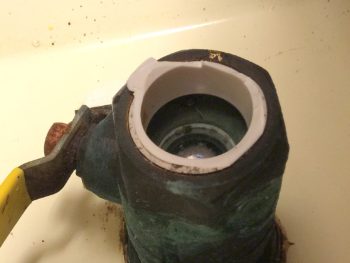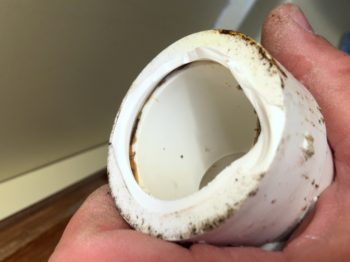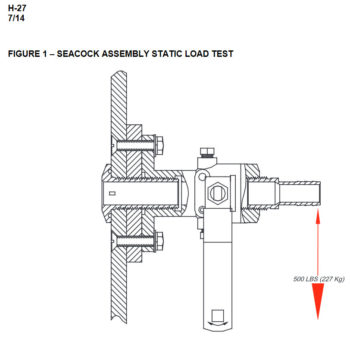Oh Fu¢k..!!!!
I know many boat builders often used improper seacocks, eg; a ball valve threaded directly to on a thru-hull fitting as well as seacocks not meeting the ABYC standards for strength, materials, thread compatibility etc., but really folks, Schedule 40 PVC has no place being used below the waterline on your vessel. A failure of this Schedule 40 PVC adapter almost sank this boat.
In mid June I got a panic call from a transient boater who was stuck in Falmouth, ME after having sailed here from Massachusetts. Apparently, somewhere off the Isle of Shoals NH, the owners wife went below to open the overboard discharge, 3 miles off shore, in order to drain their full holding tank. This led to a bad chain of events all due to sub standard & non ABYC complaint boat building practices.
Due to the very poor location & orientation of the seacock, by the builder, to open it required a bit of forearm bracing on the hose/male adapter for leverage. The installed location also required the operator to be a borderline contortionist.. Let me stop right here and point out that this boat was not built to ABYC safety standards in this regard:
ABYC H-27 “27.6.2 Seacocks shall be readily accessible as installed, and so oriented that their handles are easy to operate.”
When the owners wife braced her forearm, and lifted the handle, she heard a funny noise. With the seacock now about half open she again braced and lifted, only this time she was met with a face full of seawater and holding tank contents… D’oh……
This particular 1 1/2″ valve, for direct overboard discharge, did not get used or exercised much, as a result it had become quite stiff or far stiffer than it should be. The effects of holding tank contents, including uric acid, on a valves ball can lead to surface pitting & corrosion and can cause them to become quite stiff. All seacocks should be cycled or exercised regularly in order to help minimize this. By cycling the ball regularly it “wipes” the balls surface on the valve seats before permanent adhesion can take place. Regularly cycling or exercising your seacocks is one of the best things you can do for them to keep them in smooth operational order.
When the owners wife got doused in the face with seawater she initially had no idea what had happened, but quickly realized they had a 1 1/2″ diameter hole in the boat well in excess of 3 miles from the nearest land. She screamed in such a panicked tone her husband literally dove below so fast he missed the companionway all together. He nearly broke his arm doing so. With some moves a Yoga instructor would be proud of, in the midst of geyser in full flow, he was finally able to get the valve mostly closed. With less water flow and a calmer mind he performed a few more open/close cycles, with faces full of water each time, the valve was able to be closed. Once the valve was closed they energized the bilge pumps and began the clean up process.
According to the owner, his wife then began violently throwing up due to the stench of the holding tank contents that were now mixed with what the owner estimates as about 35 -50 gallons of “shitty water“…. Not really what I would define as a fun trip to Maine to begin your cruise.
150% Unacceptable & Totally Unavoidable
I hear it over and over from owners about how they choose to leave seacocks open, when the boat is unattended, because they are just too hard to access. This is simply bad form on the part of the builder and not ABYC complaint.
This seacock was quite stiff, poorly located and was installed with sub-standard non-compliant PVC fittings. The mere bracing of a forearm on the male adapter & 1 1/2″ sanitation hose, while trying to open this seacock, causes the Schedule 40 PVC to fail. This is 150% unacceptable and completely avoidable, had the safety standards been adhered to when the builder constructed this vessel. When thinking about this situation, on-top of the PVC failure, think:
- What if the seacock could not have been closed once partially opened?
- What if this occurred in rough seas?
- What if the handle stripped the shaft when partially open?
- Are you actually prepared to deal with an event like this?
- Are you willing to accept a boat filled with 35-50 gallons of “shit water”?
If the answer to any of these questions is no, then please ensure your vessels seacocks are installed and constructed to meet the bare minimum safety standards. It may just save your vessel or your life.
This owner actually thought he was prepared, but he soon realized that his soft-wood tapered safety plugs, the ones we all have aboard, would not fit into the seacock with a partially closed ball.. Oops…
This scenario is something I had actually not considered either, but it sure suggests that a hand saw should also be on-board to trim a plug to the correct depth if needed. While I do carry a hack saw on-board, and it could work, it would be extremely slow due to the ultra fine teeth of a metal cutting hack saw. The point here is to consider every failure point & scenario in a seacock assembly and be prepared for it ahead of time.
ABYC Seacock Strength Requirements
The ABYC standards are very clear on the testing requirements for installed seacocks yet numerous builders over the years, including many current production boats, blatantly ignore these requirements. The builder of this boat completely ignored the bare minimum ABYC safety standards adn this boat was built by a builder who was an ABYC member/builder.
The ABYC/UL strength test is performed at the innermost part of an installed seacock, usually the male hose adapter, innermost portion of an elbow or the innermost portion of the assembled seacock. The test requires the seacock assembly withstand a 500 pound static load for at least 30 seconds and not allow any ingress of water.
“27.6 INSTALLATION
27.6.1 A seacock shall be securely mounted so that the assembly will withstand a 500 pound (227 Kg) static force applied for 30 seconds to the inboard end of the assembly, without the assembly failing to stop the ingress of water (see Figure 1).”
The European ISO/RCD standards are slightly different than ABYC requiring 337 pounds of force at a position of 20 mm inboard from the internal end of the fitted seacock. This 337 pounds of force is cycled 10 times. The seacock is then tested to 1 Bar of pressure and can not allow any water to leak in and must operate as intended.
Regardless for which standard you choose, a fore arm merely bracing against the hose, while opening a seacock handle, is a gross failure to adhere to either standards and to construct a safe vessel. This should have been installed correctly by the builder but it also should have been noted by the owners insurance surveyor, neither of which occurred. This boat was built during a time period all these ABYC requirements were in place so there was no excuse for this level of cheap-skateism..
Just for grins I tried to press my forearm against my load cell, in order to see how much pressure I could deliver. Suffice it to say I was not even in the ball park, let alone the league, and my arm hurt for a solid week.
There are only a few seacock materials that should really be used below the waterline and those are:
Marine Bronze – In the US this is usually manufactured from an 85-5-5-5 metallurgy. An 85-three-five bronze alloy is roughly; 85% Copper, 5% tin, 5% lead and 5% Zinc. Reputable manufacturers of 85-5-5-5 bronze seacocks and adapters include; Apollo/Conbraco, Groco, Buck Algonquin, Perko & Spartan Bronze. Any Bronze seacock, thru-hull, elbow, male adapter etc. should wear the marine UL labeling and be 100% galvanically compatible with what it is mated to. Mixing dissimilar metals below the waterline is a recipe for disaster.
Forespar® “93” series Marelon – Marelon is a glass reinforced nylon product by Forespar. *Only the OEM / “93” Series Seacocks have been tested to ABYC strength requirements.
TruDesign Plastics – TruDesign is another glass reinforced nylon product that meets the ABYC strength requirements in most sizes.
Please, please, please take your seacocks and below waterline fittings seriously:
- Inspect them regularly
- Cycle them regularly
- Locate them for easy access
- Use marine rated hose intended for below water-line applications
- Use flanged seacocks
- Use non-perforated 316SS hose clamps from either ABA or AWAB
- Make sure your male adapter is long enough to accept two hose clamps
- Do use galvanically compatible materials
- Do use Marelon, 85-5-5-5 Marine bronze or TruDesign Seacocks
- Do not use PVC
- Do not use yellow brass fittings
- Always ensure threads are compatible
For more information on seacocks see the other MarineHowTo.com articles below:
Seacocks Strainers & Hose Clamps
Good luck & happy boating!
Like What You Saw Or Read?
Would you like to see more articles like this? Is so feel free to donate, support the site and keep it growing.
Please DO NOT feel obligated at all. If you like it and want to make a small donation than that’s all I ask.
Your donations help keep the content coming and also help keep it free.
Click the DONATE button below if you would like to make a donation via PayPal.



